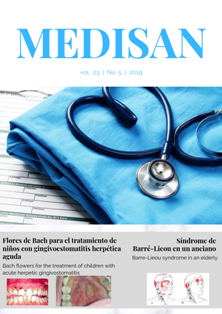Bach flowers for the treatment of children with acute herpetic gingivostomatitis
Keywords:
child, herpetic gingivostomatitis, floral therapy, Bach flowers.Abstract
Introduction: Acute herpetic gingivostomatitis is the most common form of infection in childhood.
Objective: to evaluate the effectiveness of Bach's floral therapy in children with this infection.
Methods: A study of therapeutic intervention in 42 children from 2 to 6 years of age who went to the Stomatology Department of Dr. Juan Bruno Zayas Alfonso Teaching General Hospital was carried out, from 2016 to December, 2018. They were distributed in 2 groups in a random way, with 21 members each: that of study (even numbers), received the floral therapy sublingually, and that of control (odd numbers), was treated in the habitual way with acyclovir in cream on the lesions. For the gathering of the data a schedule was made which included the clinical course of the clinical and psychological symptoms evaluated in the interview to the parents and in the clinical exam. Percentage was used as summary measure and the Chi squared statistician with a confidence of 95 %.
Results: In the study group there was a clinical improvement of the symptoms in more than 50.0 % of the patients at the 72 hours of receiving the treatment and in 100.0 % of these to the seventh day; however, in the control group this improvement was achieved in 57.1 % of those affected.
Conclusions: The favorable clinical and psychological clinical course showed the usefulness of this therapy in the children with acute herpetic gingivostomatitis.Downloads
References
2. Iriquin SM, Rom MG, Ruiz ME, Hernández SF. Virus del herpes simple 1 (HSV-1): Agente etiológico de una patología frecuente en niños y jóvenes. La Plata: SEDICI; 2017.
3. Estrada Pereira GA, Díaz Fernández JM, Márquez Filiu M, Agüero Despaigne LA. Terapias oncoespecíficas en pacientes con virus del herpes simple bucal. MEDISAN. 2017 [citado 07/04/2018]; 21 (2). Disponible en: http://scielo.sld.cu/scielo.php?script=sci_arttext&pid=S1029-30192017000200005
4. González Díaz ME, Toledo Pimentel B, Sarduy Bermúdez l, Morales Aguiar DR, Samper HR, Veitia Cabarrocas F, et al. Compendio de Periodoncia. 2 ed. La Habana: Ecimed; 2017. p. 157-58.
5. Hantz S, Alain S. Infecciones por el virus del herpes simple. EMC – Pediatría. 2018 [citado 07/12/2018]; 53 (2): 1-13. Disponible en: https://doi.org/10.1016/S1245-1789(18)89722-0
6. Callís Fernández S. Terapia floral de Bach en niños con manifestaciones de hiperactividad. MEDISAN. 2011 [citado 07/04/2018]; 15 (12). Disponible en: http://scielo.sld.cu/scielo.php?script=sci_arttext&pid=S1029-30192011001200007
7. Llundo Agualongo NM. Evaluación de la efectividad del tratamiento con esencias florales en escolares con síntomas de estrés postraumático a causa del terremoto, en la Unidad Educativa San Luis Gonzaga (Muisne-Ecuador) durante el año 2016. Riobamba: Escuela Superior Politécnica de Chimborazo; 2017 [citado 07/04/2018]. Disponible en: http://dspace.espoch.edu.ec/bitstream/123456789/6938/1/56T00740.pdf
8. Valdés Jiménez de Castro M, Jiménez de Castro Morgado MI, Colas Costa M, García Pérez A. Programa de superación profesional para médicos de la familia sobre gingivoestomatitis herpética aguda. Rev EDUMECENTRO. 2015 [citado 08/12/2015]; 7 (2): 62-75. Disponible en: http://scielo.sld.cu/scielo.php?script=sci_arttext&pid=S2077-28742015000200006
9. Pérez de Alejo Rodríguez L, Alba Pérez L, Pérez de Alejo Rodríguez M, Moré Chang CX, Rega Echeverría D, Blanco Ramos C. Aplicación de la terapia floral en pacientes con enfermedades autoinmunes. Acta Médica del Centro. 2014 [citado 07/04/2015]; 8 (1). Disponible en: https://www.medigraphic.com/pdfs/medicadelcentro/mec-2014/mec141c.pdf
10. Lima Álvarez M, Casanova Rivero Y. Miedo, ansiedad y fobia al tratamiento estomatológico. Rev Hum Med. 2006 [citado 07/04/2015]; 6 (1). Disponible en: http://scielo.sld.cu/scielo.php?script=sci_arttext&pid=S1727-81202006000100007
11. Egas Montalvo CD. Prevalencia de las patologías en cavidad bucal en niños de 0-3 años de edad en el Patronato San José, periodo 2016. Quito: UCE. p.120; 2017 [citado 07/04/2015]. Disponible en: http://www.dspace.uce.edu.ec/bitstream/25000/10718/1/T-UCE-0015-670.pdf
12. Perdomo Vergel S, Núñez Pantoja D, García Yánez R. Tratamiento de la estomatitis aftosa con terapia floral. Barcelona: SEDIBAC; 2013 [citado 07/04/2015]. Disponible en: http://sedibac.org/wp-content/uploads/2013/03/tema_estomatitis_aftosa.pdf
13. Dantas Martins HD, Sarmiento Pinto P, Candeia Lyra T, Nicolau Ferreira VY, Ferreti Bonan PR. Gingivoestomatitis herpética en paciente adulto. Rev Cubana Estomatol. 2018 [citado 07/12/2018]; 55 (4). Disponible en: http://revestomatologia.sld.cu/index.php/est/article/view/1797/450
14. Vara Delgado A, Doce Polón E, Moret Vara S. Tratamiento de la gingivoestomatitis herpética aguda. AMC. 1999 [citado 07/04/2018]; 3 (3). Disponible en: http://scielo.sld.cu/scielo.php?script=sci_arttext&pid=S1025-02551999000300012
15. Pérez GMC, Naranjo VY, Torralba EL, Tamayo ÁY, Jorge FE. Intervención educativa sobre gingivoestomatitis herpética aguda, dirigida a médicos de la atención primaria
CCM. 2017 [citado 07/04/2018]; 21 (3). Disponible en: https://www.medigraphic.com/pdfs/correo/ccm-2017/ccm173c.pdf
16. Casamayou R, Izquierdo Rabellino S, Der Boghosian E, Núñez Jorge G, Pérez M. Lesiones de la mucosa bucal en una población infantil de Montevideo, Uruguay. Actas Odontol. 2016 [citado 07/04/2018]; 13 (2). Disponible en: http://www.scielo.edu.uy/scielo.php?script=sci_arttext&pid=S2393-63042016000200004
17. Duque Álzate D, López Arévalo DC, Hernández Perafán LF. Actualización de guías clínicas y procedimientos del profesional de odontología e higienista oral en Red de Salud Armenia ESE. Colombia: Universidad Cooperativa de Colombia; 2018 [citado 07/12/2018]. Disponible en: http://repository.ucc.edu.co/handle/ucc/6865
Published
How to Cite
Issue
Section
License
All the articles can be downloaded or read for free. The journal does not charge any amount of money to the authors for the reception, edition or the publication of the articles, making the whole process completely free. Medisan has no embargo period and it is published under the license of Creative Commons, International Non Commercial Recognition 4.0, which authorizes the copy, reproduction and the total or partial distribution of the articles in any format or platform, with the conditions of citing the source of information and not to be used for profitable purposes.





